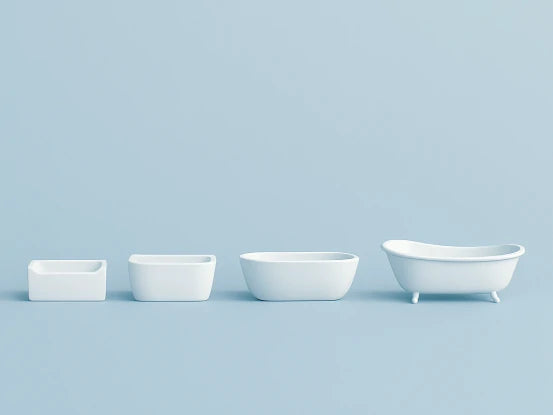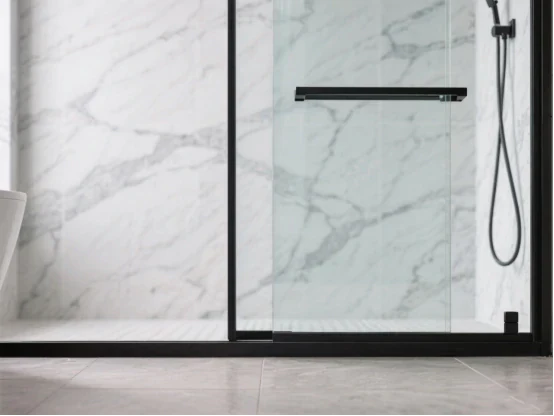Are you planning a bathroom remodel and trying to figure out the right bathing tub standard size? You're in the right place. Getting clear on dimensions is the first step to a successful project, as size is an important decision. Whether you're building a new home, renovating an old bathroom, or simply replacing a worn-out tub, understanding the industry-standard bathtub size is essential. The most common standard bathtub size is 60 inches long, 30 inches wide, and 14 to 16 inches high. Knowing these bathtub standard measurements and dimensions for a bathtub. helps you plan for comfort, meet building codes, and protect your home's resale value.
This guide provides data-driven answers to help you choose the right size for your relaxing bath. perfect tub for your space and needs.
At-a-Glance Sizing Table: Standard, Compact, and Oversized Bathtubs
To help you quickly compare options, here is a summary of the most common tub sizes. Think of how each footprint would fit in your bathroom to help guide your decision.
| Tub Type | Standard Length (in) | Width (in) | Height/Depth (in) | Best For |
|---|---|---|---|---|
| Small Alcove | 54 | 30 | 15 | Tiny bathrooms, older home retrofits |
| Alcove (Standard) | 60 | 30–32 | 14–18 | Most homes, apartments, guest baths |
| Soaking Tub | 60–72 | 32–36 | 18–24 | Spa-like, full-body soak |
| Freestanding Tub | 55–72 | 27–32 | 15–24 | Statement bathrooms, luxury remodels |
| Clawfoot Tub | 54–72 | 27–40 | 23–30 | Vintage style, deeper tub for soaking |
For a quick comparison, imagine each of these tubs placed within a standard 5-foot by 8-foot bathroom layout. The standard alcove tub would fit snugly, while a freestanding tub would require more open floor space.

Bathing Tub Standard Size by Type
Bathtubs come in various sizes, including whirlpool and air tubs. Bathtubs come in various shapes and sizes for alcove installations., each designed for a different purpose and bathroom layout. Understanding the dimensions of each type of bathtub is key to choosing the right bathtub size.
Alcove Bathtub: The North American Standard
The alcove bathtub is the most common bathtub found in homes across the country. These tubs are designed to fit perfectly into a three-walled enclosure, making them a space-efficient choice for most full bathrooms, while freestanding tubs hold more water than the average bathtub.
Standard Exterior Dimensions: 60 inches in length, 30 inches in width, and 14 to 16 inches in height. This is the classic 5 feet long tub.
Fits: This bathtub size is typically 60 inches, making it ideal for primary and secondary bathrooms in houses, apartments, and most retrofits. If you are replacing an old tub, chances are it is a whirlpool tub or a common size is 60 inches model. 60-inch alcove model.
Ergonomics: moderate depth is practical for quick bathing, showering, and bathing children, making it a perfect bathtub for families. It's also relatively easy to clean and maintain.
Soaking Tub
A soaking tub is built for a relaxing and immersive bathing experience. Its main feature is its increased depth, which allows you to submerge your entire body.
Dimensions: 60–72 inches in length, 32–36 inches in width, and 18–24 inches in height.
Best for: A soaking tub is perfect for unwinding and achieving a spa-like feel at home. They are popular upgrades for master suites.
Note: Because soaking tubs can be even larger and deeper, they require more bathroom space and hold more water, which can increase your water heating costs and the total weight on your floor.
Freestanding & Clawfoot Tubs
Freestanding and clawfoot tubs are statement pieces that act as a bathroom's focal point, especially when considering freestanding bathtub sizes. Unlike alcove tubs, they are not attached to walls and require finished flooring and wall surfaces on all sides.
Freestanding Tub Dimensions: Freestanding tubs come in a wide range, from 55 to 72 inches long and 27 to 32 inches wide, with heights of 15 to 24 inches. The most common size for a freestanding tub is around 60 inches long.
Clawfoot Tub Dimensions: A clawfoot tub is typically 54 to 72 inches long and 27 to 40 inches wide. Their classic design often includes a height of around the bathtub that complements modern aesthetics, making it a common size is 60 inches. 23 to 30 inches, offering a nice, deep soak.
Fit: These tubs are ideal for large, luxury bathrooms where space is not a concern. Freestanding tubs require sufficient space around the tub for cleaning and movement, usually at least 4-6 tub options inches of space around all sides.
Other Common Bathtub Types
Corner Tubs: Designed to save space in unique layouts, a corner tub often measures 60 inches by 60 inches, a larger tub may provide more comfort with a height of 18 to 22 inches. They provide a large bathing well but can dominate a smaller room.
Drop-in/Oval Tubs come in various sizes to suit different preferences: A drop-in tub is a shell that is installed into a custom-built deck or surround. An oval tub is a popular style for this. Dimensions typically range from 60 to 72 inches in length and 30 to 36 inches in width. These tubs offer a seamless, integrated look.
Walk-in Tubs (ADA Compliant): Designed for safety and accessibility, walk-in tubs feature a watertight door. Their dimensions usually run from 48 to 60 inches is the range in size for many standard bathtubs available today. 28 to 32 inches wide, and 36 to 40 inches high to accommodate a built-in seat.
Planning & Fitting: How to Choose Your Tub Size

Choosing the right bathtub involves more than just picking a style. You need to ensure the new tub will physically fit and function correctly in your space.
Measure Your Space Accurately
Before you select a bathtub, take precise measurements of your bathroom.
Measure the Alcove (If Applicable): For an alcove tub, measure the length between the studs (not the drywall) of the three walls. A standard alcove is just over 60 inches wide to accommodate a standard tub.
Measure for Clearance: For a freestanding tub, measure the total floor area. You need to plan for adequate clearance on all sides for cleaning and easy access. A good rule of thumb is at least 4 inches of open space on all sides to ensure the tub will fit.
Check Your Path: Don't forget to measure doorways, hallways, and stairwells. A large cast iron tub won't do you any good if you can't get it into the bathroom.
Consider Bathroom Size and Building Codes
The overall size of your bathroom will heavily influence your choice of the chosen bathtub.
Minimum Full Bath Size: A standard full bathroom is about 40 square feet (e.g., 5 ft x 8 ft). This layout is designed to fit a standard 60-inch tub alongside a toilet and vanity.
Building Codes: Local building codes often dictate minimum clearances. For example, many codes require at least 21 inches of clear space in front of the bathtub. The International Residential Code (IRC) provides guidelines that local authorities often adopt, so it's wise to check your local requirements before starting a project.
Small Bathrooms: For bathrooms under 40 square feet, a standard bathtub might feel cramped. In these cases, smaller tubs (like a 54-inch model) or a standalone shower may be a better option.
Accessibility and Aging-in-Place
If you are planning for long-term accessibility, a walk-in tub is an excellent choice. When planning for one, account for the door swing (either inward or outward) and ensure there is enough room for a person to safely enter and exit. The Americans with Disabilities Act (ADA) provides specific guidelines for accessible bathroom design, including grab bar placement and clear floor space, which are helpful for any accessible remodel.
Materials and Durability Considerations
The material of your bathtub affects its weight, durability, heat retention, and cost. The size is typically 60 inches for most material types, but some are more common in larger sizes.
Acrylic: This is a very popular material because it's lightweight, affordable, and available in many standard dimensions. shapes and sizes. Its lightweight makes it a great option for DIY installations and upper-floor bathrooms.
Fiberglass: The most affordable option, fiberglass is also lightweight and easy to install. It's most common for a standard alcove tub but is less durable and more prone to scratching than acrylic.
Cast Iron: Cast iron tubs are incredibly durable and have excellent heat retention, keeping your bathwater warmer for longer. However, they are extremely heavy and may require extra floor support, especially for larger tubs can provide a relaxing bath experience with ample space..
Enameled Steel: A lighter and more affordable alternative to cast iron, enameled steel tubs are also durable but may chip more easily and do not retain heat as well.
Cleaning Note: Smaller tubs are generally easier to clean. A deep soaking tub may require more effort to reach the bottom and ensure proper drainage and drying to prevent mildew.

Installation, Cost, and Remodeling Tips
Installing a new bathtub comes with its own set of challenges, especially when changing the size or style.
Cost Factors: The price of a bathtub goes up with size and material. Larger tubs not only cost more to purchase but also increase labor costs for installation and potentially plumbing modifications. A heavy cast iron tub might also require a contractor to reinforce the floor joists, adding to the expense.
Installation Hurdles: Swapping a standard 60-inch alcove model for another of the same size is straightforward. However, installing a 72-inch soaking tub in its place will require reframing the wall. Installing a freestanding tub where an alcove tub once was will require plumbing relocation and patching the floor and walls.
Pre-Installation Checklist:
Here is a simple checklist to use before you choose a tub that suits your style and offers the comfort of a quick shower option:
Verify Clearances: Double-check that the uncrated dimensions for a bathtub fit your intended installation area. Tubs can fit through all doors, hallways, and stairs.
Confirm Drain Alignment: Check if your new tub's drain is on the left, right, or center, and ensure it matches your existing plumbing for the chosen bathtub. If not, budget for a plumber to move it.
Assess Floor Strength: For heavy tubs like cast iron or large, filled soaking tubs, consult a contractor to confirm your floor can support the weight. A filled 72-inch soaking tub can weigh over 1,000 pounds.
Real-World Insights & Trends
What are builders and homeowners actually choosing? Recent data gives us a clear picture.
Builder Analysis (2024–2025): Industry reports and homebuilder project plans show that the 60" x 30" alcove tub continues to dominate new construction for secondary and guest bathrooms. It is the most economical and practical choice that appeals to the widest range of buyers looking for the best tub. For custom homes and master suite upgrades, however, the trend is shifting towards larger tubs, particularly freestanding and soaking tub models that offer a luxury freestanding bathtub for your space in various sizes. bathing experience.
Homeowner Feedback: A review of online forums and social media from 2023-2025 reveals a similar story. Homeowners in typical tract homes or apartments who are remodeling often stick with the standard bathtub dimensions of 60 inches in length because it's a simple, direct replacement. Those with more space and a larger budget frequently express a preference for a deeper tub or a stylish freestanding bathtub to create a personal oasis with various tub options. The consensus is that the 60"x30" footprint is the "safe bet" for functionality and resale.
Conclusion
When it comes to the bathing tub standard size, the clear winner for most American homes is the 60-inch long, 30-inch wide, and 14 to 16-inch high alcove model. This bathtub size is practical, cost-effective, and meets the needs of the average family. It fits neatly into most full bathrooms, complies with building codes, and simplifies installation.
While larger tubs like soaking or freestanding models are growing in popularity for master bathrooms and luxury remodels, the classic 60-inch tub remains the trusted baseline. No matter which bathtub style you are considering, the key is to measure your space carefully, understand your needs, and review local building codes. By doing your homework, you can confidently choose a bathtub that will provide comfort and value for years to come.
Frequently Asked Questions
1. What is the size of a standard bathtub?
The typical bathtub dimensions in North America measure 60 inches in length and 30 inches in width with a height range between 14 to 16 inches. The standard 5-foot alcove accommodates this bathtub size which measures 60 inches long and 30 inches wide.
2. What is the most common size of a freestanding tub?
The standard length of freestanding tubs exists at 60 inches but manufacturers produce them in dimensions ranging from 55 to 72 inches to accommodate different bathroom sizes and user needs.
3. What is the difference between a soaking tub and a regular bathtub?
The main distinction lies in the depth measurement. Standard tubs reach water depths between 14 to 16 inches, which works well for typical bathing needs and allows the user to fill the tub comfortably. Soaking tubs provide deeper water immersion because their depth ranges between 18 to 24 inches and extends beyond that. The deep water level enables complete body submersion for therapeutic relaxation.
4. Is a 59-inch tub too small?
A 59-inch tub is not too small; it's a practical solution for non-standard spaces. Many older homes have alcoves that are slightly smaller than the modern 60-inch standard. A 59-inch tub can provide a perfect fit without requiring costly framing changes. For most adults, the one-inch difference in length is barely noticeable.
5. Do building codes affect my choice of bathtub?
Yes, they can. Building codes at the local level require specific clearance dimensions for fixtures to guarantee safety and usability. The tub requires a specific amount of open floor space in front of it. The building codes establish rules for plumbing systems including drain dimensions and venting requirements. Before making your final bathtub selection you should verify the requirements with your local building authority.








Leave a comment
This site is protected by hCaptcha and the hCaptcha Privacy Policy and Terms of Service apply.